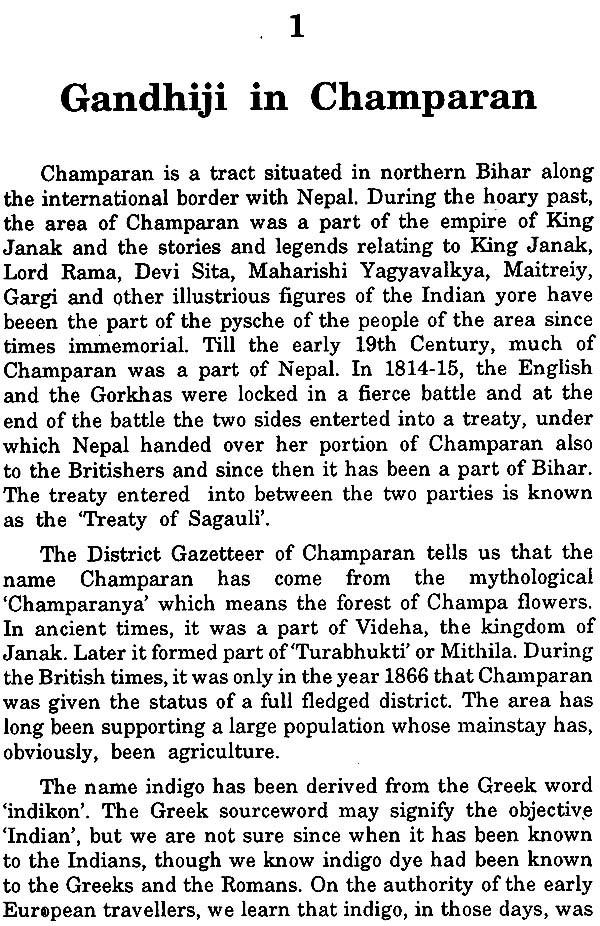
Gandhi's First Step- Champaran Movement
Book Specification
| Item Code: | AZE528 |
| Author: | Shankar Dayal Singh |
| Publisher: | B.R. Publishing Corporation |
| Language: | ENGLISH |
| Edition: | 1994 |
| ISBN: | 8170188342 |
| Pages: | 280 |
| Cover: | HARDCOVER |
| Other Details | 9.00x6.00 |
| Weight | 500 gm |
Book Description
He visited Champaran to have first-hand knowledge about the sufferings of the tenant peasants. Statements of about 13,000 tenant peasants were recorded by the followers of Gandhiji in this connection. On the basis of these statements, Lt. Governor of the State constituted an Enquiry Committee of which Mahatma Gandhi was also a member.
The main objective of the book is to present to the public a selection of typical examples of the statements of the peasant tenants. The statements included in the book are without any editing, and as they were originally recorded by eminent. leaders like Rajendrababu, Shri Brij kishore Prasad and others. However, for the ease of the reader, a write up explaining the typical examples of atrocities, has also been included in the book.
For the purpose of understanding the Champaran Movement in its proper perspective, the author has included in the book all the relevant documents in respect of the findings, the outcome of the moveme and Gandhiji took his first step of the freedom struggle of India in April 1917, in Champaran tract in North Bihar through his norms of non-violent adherence to the path of truth, faimess and justice in the face of the most hideous odds.
He visited Champaran to have first-hand knowledge about the sufferings of the tenant peasants. Statements of about 13,000 tenant peasants were recorded by the followers of Gandhiji in this connection. On the basis of these statements, Lt. Governor of the State constituted an Enquiry Committee of which Mahatma Gandhi was also a member.
The main objective of the book is to present to the public a selection of typical examples of the statements of the peasant tenants. The statements included in the book are without any editing, and as they were originally recorded by eminent. leaders like Rajendrababu, Shri Brij kishore Prasad and others. However, for the ease of the reader, a write up explaining the typical examples of atrocities, has also been included in the book.
For the purpose of understanding the Champaran Movement in its proper perspective, the author has included in the book all the relevant documents in respect of the findings, the outcome of the moveme and Front Cover Gandhill in his cap popularly known as GANDHI CAP-"The Symbol of Nationalism"
Dr. Singh was conferred with Vidya Varidhi (D. Litt.) by Vikram Shila Vidyapeeth, in 1988. He was honoured with the Award of 'Bihar Ratna' in 1990 for the Cultural, Social and Literary Services rendered by him. He was also honoured with the 'Shevde Hindi Sevi Puraskar' by the President of India in 1993, for prestigious services of Rashtra Bhasha, Hindi.
Dr. Shankar Dayal Singh is the Chairman of Delhi Public Library: Vice Chairman of the Parliamentary Committee on Official Language; Deputy Chairman of All India Council for Child Development, and the Vice President of Bihar Hindi Sahitya Sammelan, besides being on the commi ttees of various other cultural, social and educational institutions. Dr. Singh has made very valuable contributions to the socio-political and cultural life of India.
Thus started the compaign in a relatively unknown area of Bihar which was to be an example for the Freedom Struggle. 18th April 1917 Is a historic day. In our Independence Movement as Bapu rejected the colonial demand to leave Champaran and prepared to go to jall. Appearing before the Magistrate, Bapu stated what was to become the Philosophy of our Satyagraha:
"I have disregarded the order served upon mo not for want of respect of lawful authority, but in obedience to the higher law of our being, the voice of conscience"
His decision Immediately inspired others to offer disobedience. Bapu demonstrated to the world how an oppressed, indigent and unlettered populace can stand up and make the oppressor bend. By the time the Champaran Campaign reached its logical end, M.K. Gandhi had become Mahatma Gandhi.
It has been to matter of great satisfaction for me, that I have been able to preserve all these years the statements of some two thousand farmers that had been tendered and typed way back in 1917 as an invaluable treasure. As I belong to the family of freedom fighters and am an ardent believer and follower of the ideals of Gandhiji I have taken special care to ensure that 3 volumes of these documents which were located by me were preserved.
Two of these volumes were received by me from Late Shri Rameshwar Prasad Singh, a relative of my wife. He was the Manager of Betiaha Raj. The other volume was located by me at the Congress Office in Champaran District. These typed copies tell us the names of the persons who had given their statements and the dates on which these statements had been given; but the more important thing is that the typed copies bear the signature of Rajendra Babu, Brij Kishore Prasad and Anugrahababu and others and all these have been preserved to this day. Obviously, this is a rare document. It has also tick marks in pencil about which it is said that these had been put by Gandhiji himself.
**Contents and Sample Pages**













